
In photography and cinematography, a wide-angle lens is a lens covering a large angle of view. Conversely, its focal length is substantially smaller than that of a normal lens for a given film plane. This type of lens allows more of the scene to be included in the photograph, which is useful in architectural, interior, and landscape photography where the photographer may not be able to move farther from the scene to photograph it.

Sigma Corporation is a Japanese company, manufacturing cameras, lenses, flashes and other photographic accessories. All Sigma products are produced in the company's own Aizu factory in Bandai, Fukushima, Japan. Although Sigma produces several camera models, the company is best known for producing high-quality lenses and other accessories that are compatible with the cameras produced by other companies.

Advanced Photo System type-C (APS-C) is an image sensor format approximately equivalent in size to the Advanced Photo System film negative in its C ("Classic") format, of 25.1×16.7 mm, an aspect ratio of 3:2 and Ø 30.15 mm field diameter. It is therefore also equivalent in size to the Super 35 motion picture film format, which has the dimensions of 24.89 mm × 18.66 mm and Ø 31.11 mm field diameter.

The double Gauss lens is a compound lens used mostly in camera lenses that reduces optical aberrations over a large focal plane.

The EF 85mm lenses are a group of medium telephoto prime lenses made by Canon Inc. that share the same focal length. These lenses have an EF type mount that fits the Canon EOS line of cameras.

The Sigma 30mm f/1.4 EX DC HSM is a wide-aperture photographic lens made by the Sigma Corporation, equipped with a Hyper Sonic Motor. The lens was produced in Canon EF mount, Four Thirds System, Nikon F-mount, Pentax K mount, the SA mount, and the Sony/Minolta AF Mount varieties, all of the same optical formula. It shipped with a removable petal-type lens hood. The lens assumes a crop factor of roughly 1.5, and therefore is not usable with on full-frame or 135 film cameras.
The EF 300mm lens refers to a family of telephoto prime lenses made by Canon, five of which have been sold to the general public and one of which was only made on special order. The lenses have an EF type mount which fits the Canon EOS line of cameras.

The EF 28mm lenses are a group of prime lenses made by Canon that share the same focal length.

This article details lensesfor single-lens reflex and digital single-lens reflex cameras. The emphasis is on modern lenses for 35 mm film SLRs and for "full-frame" DSLRs with sensor sizes less than or equal to 35 mm.

The Sigma 18-50mm f/2.8 EX DC Macro is a wide to normal angle, zoom lens made by the Sigma Corporation.

The Sigma 12-24mm f/4.5-5.6 EX DG HSM is a professional-level wide-angle zoom lens made by Sigma Corporation. At launch it was the widest rectilinear lens available for full-frame 35mm SLR cameras, providing a field of view of 122 degrees. It has since been surpassed by the Canon EF 11-24mm f/4L zoom lens and the Irix 11mm f/4, a manual focus prime lens. The Sigma 12-24 has low distortion even compared to less wide zooms like the Canon EF 16-35mm lens.

The Sigma APO 180mm F3.5 EX DG lens was a telephoto/macro lens produced by Sigma Corporation. It contained two SLD glass elements to provide correction for chromatic aberration and was aimed toward advanced consumers.

The EF 35–350mm f/3.5–5.6L USM lens is a discontinued telephoto zoom lens manufactured by Canon.

The Sigma 8–16mm lens is an enthusiast-level, ultra wide-angle rectilinear zoom lens made by Sigma Corporation specifically for use with APS-C small format digital SLRs. It is the first ultrawide rectilinear zoom lens with a minimum focal length of 8 mm, designed specifically for APS-C size image sensors. The lens was introduced at the February 2010 Photo Marketing Association International Convention and Trade Show. At its release it was the widest viewing angle focal length available commercially for APS-C cameras. It is part of Sigma's DC line of lenses, meaning it was designed to have an image circle tailored to work with APS-C format cameras. The lens has a constant length regardless of optical zoom and focus with inner lens tube elements responding to these parameters. The lens has hypersonic zoom autofocus.

The Sigma 35 mm f/1.4 DG HSM Art is a wide-angle prime lens made by the Sigma Corporation. The lens was announced at the 2012 photokina trade fair.

The Sigma 50mm f/1.4 DG HSM Art lens is a professional-level fixed focal length camera lens made by Sigma Corporation. It was announced at CES in January 2014 and immediately became highly anticipated amid reports that Sigma was not aiming to compete against Canon or Nikon's 50mm prime lenses but rather the newly released Zeiss Otus 55/1.4, a lens costing US$4,000. Retail prices for the Sigma 50mm lens had not yet been announced, but it was initially expected that it would sell for around US$1,350. However, when official pricing was announced on April 11, 2014, the retail price was even lower: US$950.
The EF 11–24 mm f/4L USM lens is a professional wide-angle lens made by Canon Inc. It was announced on February 5, 2015, and at that time was the widest rectilinear lens ever made for the 35 mm format in either its film or digital versions.

The Sony Zeiss Planar T* FE 50mm F1.4 ZA is a large-aperture, standard full-frame prime lens for the Sony E-mount. It was released by Sony in July 2016.

The Canon RF lens mount is an interchangeable-lens mount developed by Canon for its full-frame mirrorless interchangeable-lens cameras, and featured first by the EOS R, followed by the EOS RP. The RF mount was announced in September 2018. In May 2022, Canon announced APS-C EOS R cameras and RF-S lenses designed for these cameras.

















